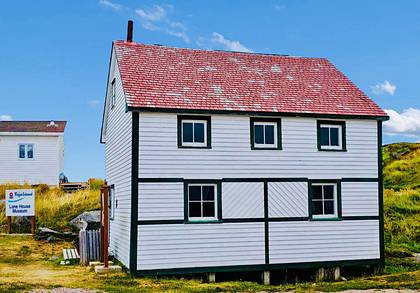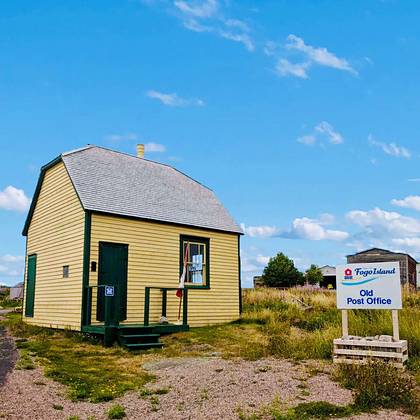Tilting

Dwyer Premises
Tilting is one of the last Newfoundland outports where you can view the full range of buildings associated with the family-based inshore fishery. Located on the eastern side of the harbour, the Dwyer Premises is situated on a peninsula that is connected to an island called "The Rock", and consists of a house, store, flakes and a stage and is remarkable in its location because of it's proximity to the water.
The House was built by Vincent Bryan between 1890 and 1900, and then purchased by Albert Dwyer in 1925. The layout is typical of Tilting's "center hall type plan". On the first floor there is a kitchen, living room, and pantry with a back kitchen and porch. On the second floor there are four small but cozy bedrooms. Small rooms, low ceilings, and exposed beams are common in the traditional structure. The house is filled with replica furniture, of the traditional design, that is made from one-hundred year old pine wood.
The store (shed) was owned by Louis Burke. It was located on Greene's Point and was floated to the Dwyer Premises for restoration. It was used mainly to store fishing nets, and then later as a stable for horse, sheep, and chicken. Inside the stage there is a rectangular hole in the middle of the ceiling that separates the first and second floor, and was used to saw plank and lumber. To do this one person stood on the loft (second floor) and one man stood on the first floor, using a two-sided pit saw and a rhythmical motion, they easily sawed through the wood.
The stage is an original part of the Dwyer Fishing Premises and won the Southcott Award in 2000, for excellence in the preservation of the architectural heritage of Newfoundland and Labrador. Before you enter you may notice a circular ornament and a horseshoe on the door. The white circle provided a sparkle in the evening, against the red background, and helped members of the household find their way towards the stage in the evening dusk. The horseshoe's purpose was to provide good-luck during the fishing season. Inside the stage you will find all the items necessary for the processing of fish by hand such as a splitting table, cod-liver oil barrel and a puncheon barrel.

Lane House Museum
Oral tradition has it that Lane House was built in the 1830s by Irish immigrant Augustin MacNamara. This would make it the oldest built structure in Tilting.
The original house was constructed in a salt box style, a form of vernacular construction featuring a two-room ground floor plan with back linhay. This style was common among first-generation settlers. An ingenious spiral staircase connects the storeys, its construction similar to that of a wooden barrel. MacNamara was a cooper and it is possible that he transferred this knowledge to the design of the staircase. The second owner, Aneas Dwyer, raised the second storey, utilizing a centre hall plan. To compensate for incongruity in terms of window placement, trim board and decorative clapboard was employed on the ground floor to create a central stylist element. This combination of housing styles speaks to the skill of the builder (oral tradition reports that Dwyer completed the renovations in one day) and the impulse in many parts of Newfoundland and Labrador to recycle and redesign older homes.
In restoring Lane House, an attempt was made to demonstrate an ability to preserve some of the features of the original structure. Deteriorating asphalt shingles on the roof were replaced with wooden shingles. All clapboards, trim, soffits, and eaves were replaced, and inappropriate windows were replaced by historically-correct two-over two on the ground floor, and a unique one-by-one on the second floor. These were all constructed of wood in traditional patterns by James Youden of St. John's.
Inside the house, the semi-circular winding staircase had fallen into decay. It was repainted and its rail restored. The handrail collides with and intersects the ladder to the attic. According to architect Robert Mellin, "The builder could have simplified construction by compromising one of these two elements, but he chose to demonstrate his skill and carefully wove the two together." The attic revealed the transformation that had occurred in the late 19th century with the raising of the roof. To show this evolution, distinctive trimwork was designed for the gable-end of the structure, which shows the original roofline of the building.
Lane House was designated a Registered Heritage Structure by the Heritage Foundation of Newfoundland and Labrador in 1994. It was restored by the Tilting Expatriates Association with the assistance of a grant from the Heritage Foundation of Newfoundland and Labrador. Robert Mellin donated architectural consulting assistance during the planning and restoration process.
Artifacts and exhibits have been collected, and the house is now open to the public as a museum during the summertime. It is presently maintained by TRACS (Tilting Recreation and Cultural Society). It stands as a testament to the dedication of a group of volunteers who wish to preserve and commemorate their community's history, and presents the best of our culture to visitors, so that they may understand our culture and way of life. The building also received the 1997 Southcott Award for excellence in heritage restoration, an award granted by the Newfoundland Historic Trust.
Link to Heritage Foundation of Newfoundland and Labrador - Lane House Registered Heritage Structure:
http://heritagefoundation.ca/property-search/property-details-page.aspx?id=1607

Old Post Office
The original Post Office in Tilting was established in 1887 and it was set up as a waystation. For many years it was located in the local fishing premises of Patrick Bryan and Sons. Patrick Bryan was awarded the contract to build the new post office and construction began in 1907. The site chosen was on the back of the McGrath and Keough neighbourhoods. Mr. Bryan hired Mr. Marks Foley to be the foreman and main carpenter on the job. Much of the building material was brought into the community by Mr. Bryan. The building was completed in 1908 and it was officially opened in the spring of that year. The first postmistress was Mrs. Isabell (Burke) McGrath and the final postmistress, when the building was decommissioned in 1969, was Mrs. Nora Foley. She was the niece of Mrs. Bell.
When the Old Post Office closed it was purchased from Canada Post by Bryan Greene, the grandson of the original contractor. He owned the building for a number of years and then sold it to Emmeline and Edward Cluett. They then lived in the structure and operated a small convenience store called "Emmeline's Groceteria". The Cluett's moved out of the building in the early 1980's and then sold it to Ambrose and Gladys McGrath. It was used as a storage and woodshed until Gladys turned it over to the Town of Tilting in 2007,so that the process of securing restoration funding could begin.
The community of Tilting and the Tilting Recreation And Cultural Society collaborated with PTV Productions Inc. of Toronto, Ontario and in 2007 it was one of just 3 projects across Canada that was selected for a documentary on heritage conservation. The film crew visited Tilting on a number of occasions in order to film the documentary during restoration work and they also financially supported the overall restoration. This award is a testament to their commitment and resolve to become involved in a project in a small isolated community on the Northeast coast of Newfoundland and Labrador.
Tilting's Old Post Office is a small building with a partial hip roof, which identified its public function. It had a small waiting room, a storage room for coal, and an office. Some details like windows and wainscot were similar to materials used in some of the churches and larger public buildings on Fogo Island.
The restoration work was done with local labour, with the occasional participation of PTV"s crew during filming, to make the documentary film more engaging.
http://www.savingplaces.ca/episode2.php
During the restoration work, a selection of old stamps were found and underneath an exterior mailbox that was hidden in the wall, a large selection of old coins, some dating back to to the early 1800's, were found. Underneath layer upon layer of canvas flooring, numerous, handwritten pages of telegraphs/telegrams, were retrieved. These sheets gave a daily account of the news from the battle front in WW1 and also local news from the courts etc.
The Old Post Office is operated as a museum.

